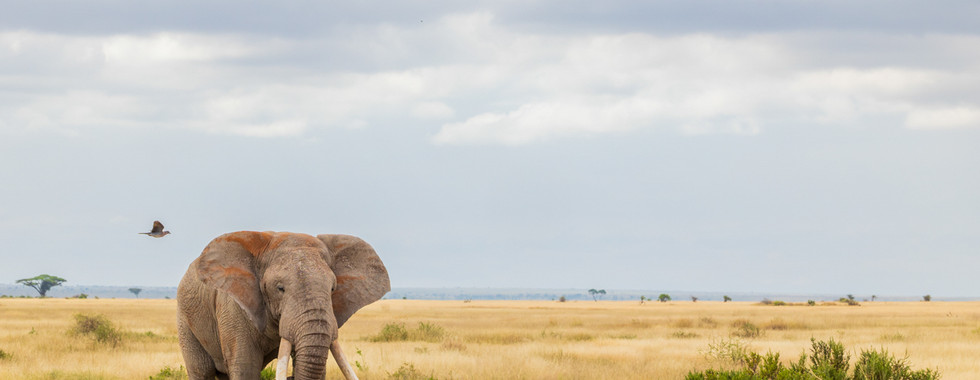Holy Mountain
- Faraaz Abdool

- Apr 21
- 7 min read
Updated: Apr 23
Nothing can reasonably prepare one to be in the presence of one of the holiest of holy mountains. Driving toward it is a unique experience - it is much too big to rise from the horizon as most landmarks do. Instead, mighty Kilimanjaro materializes out of thin air. Upon approach, a mountain-shaped region of the sky subtly begins to darken. It is at first an unwillingness to believe one’s eyes. Sunglasses may be checked and repositioned. Slowly, as the gaze turns upwards, further still, above the clouds, where the air is intolerably thin - there is rock and ice. The sight of the frozen rim of this dormant volcano proved to be as iconic and fascinating as the name itself.

“Amboseli” means “salty dust” and nowhere is a name more literal than within this park. Dramatic clouds of it surround the thundering hooves of wildebeest, safari vehicles on the other hand would attract miniature dust storms. A whipping wind would often conjure dust devils - tall, whirling towers of dust prancing across the plains. Megafauna in this park demands attention, and whether one dreams of seeing birds or beasts, the collective jaw drops in the presence of the most mega of them all: elephants.
Elephants are superlative creatures. It has been said that they are the wise guardians of the land; they certainly operate like it. To describe them all as a collective would be negating their individuality - some have a frighteningly quiet confidence while others may be shy. Elephant society mirrors what human society could (and in my view, should) be: matriarchal. Furthermore, seeing a single elephant will never be the same as seeing a herd. In fact, a herd of elephants is also called a “parade”, due in no small part to the group of elephants distinctly operating as a unit.
That being said, large bull elephants can conceal an entire solar system behind them, such is the extent of their presence. Their lengthy gait makes them arrive with an unhurried swiftness. Africa-shaped ears flap purposefully. They are the largest land animals on Earth and trod with an enviable softness. On occasion, one of these giants would approach closely - and all else seems to come to a hush. Perhaps the quietness of the elephant forces all around it to be silent - whether out of respect, reverence, or disbelief.
Regardless of how far one may be from an elephant, their attention is always felt. One morning, I spied a small group of elephants in the far distance across the plain. With binoculars, I noticed the group comprised a smaller group of smaller elephants, and a single massive bull that was distinct from the others. Flanked by a flock of egrets and a frolicking wildebeest, he occasionally let his trunk drape over either of his gigantic tusks as he sauntered loosely in our direction. Somehow, despite the great distance between us, I was acutely aware that we were in the crosshairs of this behemoth.

Over the course of the following fifteen minutes, we sat in silence as this elephant bore down on us. Like stranded sailors in a dinghy bobbing in the ocean, we stared at the shape that gradually grew larger and larger.

Of course, there is little to be said when there is an approaching elephant. But as he drew close enough for us to hear the grass swishing around his ankles, breaths were held and our driver's hand deftly grasped the keys in the ignition. We all had to be ready for the next few moments.


Our bull mounted the roadside berm and set one foot on the road. Grains of sand light enough to become dust took to the air as the sheer weight of the beast spread his footprint even wider. We were now undoubtedly directly in his path. All attention was focused, I felt hard-pressed to take my eyes away from the scene to get behind the camera.

Seemingly at the eleventh hour, the bull mounted the opposite berm and completed his road crossing. Now, almost alongside, he paused to pull some grass and urinate. Spreading his scent that can only be described as incredibly sticky, he ambled on, his avian attendants hotly in pursuit. We, however, were left spellbound, forever fundamentally altered by the experience.

Elephants would continue to do this to us periodically. Profound pachyderms, without question. I found myself wondering about the thought process of elephants as they clearly are constantly thinking about things. They know where the water is even though the river flows beneath the sand. They know who is over the horizon. They know the seasons and patterns in the flora of the land. But all of these can be attributed to their sensibilities that we are already aware of. We know this because we have the means and understanding of measurement. We understand that their soft feet are sensitive to ultrasonic waves, and that they use these low frequencies to communicate over vast distances. Their physical senses are beyond what we can grasp, while we understand the frequencies perceptible to them, we aren't aware of what picture that creates in their minds. This consideration is the topic for a separate discussion entirely, however.
There was another group of elephants we encountered a few times over our time in the park. Babies and adolescents along with a single young bull orbited a large female. She - to us at least - was clearly grandma. Wherever she went, the herd followed. Her physical appearance was unforgettable and she walked with a wise confidence. One of her tusks curved outward as tusks usually do, the other was pin straight; a shaft of ivory light. While observing them one afternoon, they seemed to notice something far in the indiscernible distance. The young bull started off in that direction, but was quickly stopped in his tracks. By what exactly, I have no idea - but he wasn't the only one that stopped. Everything stopped in that moment. Every. Single. Thing. The formerly fluid herd was now as immobile and inanimate as a stone. The aged female was fixated on whatever caught their attention, but all elephants stopped moving. None of the babies dared shake a trunk. No ear flapped, nor did any tail swish. Even the egrets and starlings did not move a feather. Maybe the mosquitoes and flies froze also. The gentle wind that was washing the plains all day was notably absent, blades of grass stood erect. In our safari Landcruiser, we dared not utter a single word. In fact, we couldn't. These are the moments that carve indelible marks into the collective psyche of the witnesses, the grossly diluted term is the "magic of safari".

I can't say how many seconds or minutes passed us by in this suspended condition, but when the straight-tusked lady decided it was time for them to continue on their original trajectory, they did; and the rest of the world was unpaused. I do not have an image of that precise moment, as I stood transfixed to the scene. I would have it no other way, though.
Many of these large animals function in similar ways to the baobabs mentioned in a previous chapter of this safari saga. There is much life that depends on their existence, from fish grazing on hippo excrement to birds grabbing insects escaping the descending foot of an elephant. Everywhere, the interconnectedness of life is on display.
In addition to the plethora of large mammals in every direction, countless birds dotted the landscape. There were plovers, sparrow-larks, and sandgrouse rummaging around in the dust along the roadways. In the small acacia trees there were shrikes, rollers, and drongos, the larger trees concealed larger suspects like eagles, vultures, and surely at least one unfindable leopard. Numerous waterways crisscrossed the land, there were ducks, geese, grebes, flamingos, jacanas, and even some over-summer shorebirds. Seedeaters of all forms swayed on grass stalks, sunbirds clutched flowering limbs. Doubtlessly one of the highest concentrations of life on the planet.
Cranes and several species of bustards strutted through the grasslands, many of them with young in tow. While not herbivores, these large birds seemed notably benign compared to the similarly sized but far fiercer Secretarybird. These Velociraptor-sized killers inspected under every bundle of scrub, eager to kick to pieces any offending animal up to the size of a small mongoose. Their scientific name Sagittarius serpentarius reflects their penchant (and clearly, fame) for dispatching snakes of both nonvenomous and venomous varieties. Overall, birds were bountiful and prolific throughout the park, and there are far too many to mention. A selection is presented in the following gallery (species names are on the individual images):
Many of these birds were also busy raising their offspring. Young storks, plovers, and pratincoles beheld the world for the first time, carefully preparing for a life lived a million times over. Plains Zebra suckled, young legs already almost as long as adults’ such that they could better escape detection among the mesmerising patterns of black and white.
Invariably though, elephants would appear - on the horizon at first, blurry through the heat haze, brownish boulders rolling across the savanna. They would never be doing nothing - elephants are always occupied. Having such a complex social structure ensures there is always something going on. They are continually interacting with one another, feeding, playing, or on a mission to go somewhere. Much of the herd orbits around older females, their wisdom and experience serving as the guiding light of the community. Young females may stumble in their first journey as mothers, but surrounded by grandmothers and aunts, she learns quickly. Adolescent males can be troublesome as in most other species, those that are still too small to move off on their own are quick to jostle with another elephant of similar persuasion. Under watchful eyes they engage in playful sparring, sometimes chasing each other, the pursuer pulling the tail of his victim once he gets within a trunk’s reach. The most pressing concern for the impossibly cute baby elephants is to wrangle their own trunks.
Amboseli truly is a spectacular, awe-inspiring destination that neither words nor images can truly do justice to. Please enjoy these few further snaps, each image is clickable.











































































































































Comments